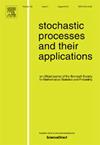Scaling limits for interactive Hawkes shot noise processes
IF 1.2
2区 数学
Q3 STATISTICS & PROBABILITY
引用次数: 0
Abstract
We introduce an interactive Hawkes shot noise process, in which the shot noise process has a Hawkes arrival process whose intensity depends on the state of the shot noise process via the self-exciting function. Namely, the shot noise process and the Hawkes process are interactive. We prove a functional law of large numbers (FLLN) and a functional central limit theorem (FCLT) for the joint dynamics of shot noise process and the Hawkes process, and characterize the effect of the interaction between them. The FLLN limit is determined by a nonlinear function determined through an integral equation. The diffusion limit is a two-dimensional interactive stochastic differential equation driven by two independent time-changed Brownian motions. The limit of the CLT-scaled shot noise process itself can be also expressed equivalently in distribution as an Ornstein–Uhlenbeck process with time-dependent parameters, unlike being a Brownian motion in the standard case without interaction. The limit of the CLT-scaled Hawkes counting process can be expressed as a sum of two independent terms, one as a time-changed Brownian motion (just as the standard case), and the other as a (Volterra type) Gaussian process represented by an Itô integral with another time-changed Brownian motion, capturing the effect of the interaction in the self-exciting function with the state of the shot noise process. To prove the joint convergence of the co-dependent Hawkes and shot noise processes, the standard techniques for Hawkes processes using the immigration-birth representations and the associated renewal equations are no longer applicable. We develop novel techniques by constructing representations for the LLN and CLT scaled processes that resemble the limits together with the associated residual terms, and then use a localization technique together with some martingale properties to prove the residual terms converge to zero and hence the joint convergence of the scaled processes. We also consider an extension of our model, an interactive marked Hawkes shot noise process, where the intensity of the Hawkes arrivals also depends on an exogenous noise, and present the corresponding FLLN and FCLT limits.
交互式Hawkes散弹噪声过程的尺度限制
我们引入了一个相互作用的Hawkes散粒噪声过程,其中散粒噪声过程具有一个Hawkes到达过程,其强度通过自激函数取决于散粒噪声过程的状态。即散粒噪声过程和Hawkes过程是相互作用的。本文证明了弹粒噪声过程和Hawkes过程联合动力学的泛函大数定律(FLLN)和泛函中心极限定理(FCLT),并描述了两者相互作用的影响。FLLN极限由一个非线性函数决定,该函数由一个积分方程决定。扩散极限是由两个独立时变布朗运动驱动的二维相互作用随机微分方程。与没有相互作用的标准情况下的布朗运动不同,clt尺度弹丸噪声过程本身的极限也可以在分布上等效地表示为具有时间依赖参数的Ornstein-Uhlenbeck过程。clt尺度Hawkes计数过程的极限可以表示为两个独立项的和,一个是时变布朗运动(就像标准情况一样),另一个是(Volterra型)高斯过程,由与另一个时变布朗运动的Itô积分表示,捕捉自激函数中相互作用与弹噪声过程状态的影响。为了证明共依赖Hawkes过程和射击噪声过程的联合收敛性,使用移民-出生表示和相关更新方程的Hawkes过程的标准技术不再适用。我们开发了一种新的技术,通过构造类似于LLN和CLT缩放过程的极限及其相关残差项的表示,然后利用局部化技术和一些鞅性质证明了残差项收敛于零,从而证明了缩放过程的联合收敛。我们还考虑了我们模型的扩展,一个交互式标记Hawkes射击噪声过程,其中Hawkes到达的强度也取决于外生噪声,并给出了相应的FLLN和FCLT极限。
本文章由计算机程序翻译,如有差异,请以英文原文为准。
求助全文
约1分钟内获得全文
求助全文
来源期刊

Stochastic Processes and their Applications
数学-统计学与概率论
CiteScore
2.90
自引率
7.10%
发文量
180
审稿时长
23.6 weeks
期刊介绍:
Stochastic Processes and their Applications publishes papers on the theory and applications of stochastic processes. It is concerned with concepts and techniques, and is oriented towards a broad spectrum of mathematical, scientific and engineering interests.
Characterization, structural properties, inference and control of stochastic processes are covered. The journal is exacting and scholarly in its standards. Every effort is made to promote innovation, vitality, and communication between disciplines. All papers are refereed.
 求助内容:
求助内容: 应助结果提醒方式:
应助结果提醒方式:


